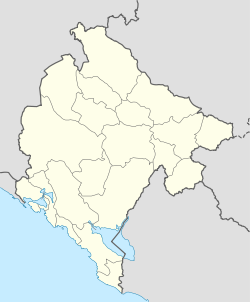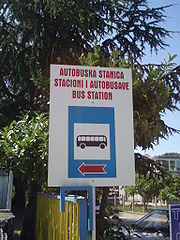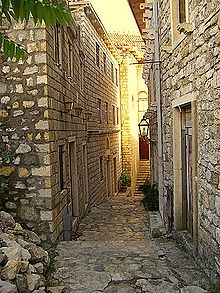- Ulcinj
-
Ulcinj 
Coat of armsLocation of Ulcinj Coordinates: 41°55′N 19°12′E / 41.92°N 19.20°ECoordinates: 41°55′N 19°12′E / 41.92°N 19.20°E Country  Montenegro
MontenegroSettlements 39 Government - Mayor Nazif Cungu (New Democratic Power – FORCA) - Ruling party New Democratic Power – FORCA Area - Total 255 km2 (98.5 sq mi) Population (2011 census) - Total 10,707 - Density 78.12/km2 (202.3/sq mi) - Municipality 19,921 Demonym Ulcinjani
UlqinakëTime zone CET (UTC+1) - Summer (DST) CEST (UTC+2) Postal code 85360 Area code +382 30 ISO 3166-2 code ME-20 Car plates UL Website http://www.komunaeulqinit.com Ulcinj (Montenegrin: Ulcinj/Улцињ, pronounced [ǔlt͡siɲ]; Albanian: Ulqin or Ulqini; Italian: Dulcigno) is a coastal resort town and municipality in Montenegro. The town of Ulcinj has a population of 10,828 (2003 census) of which the majority are Albanians. Ulcinj is the centre of the municipality and the centre of the Albanian community in Montenegro.
Contents
History
The wider area of Ulcinj has been inhabited since the Bronze Age, based on dating of Illyrian tombs (tumuli) found in the village of Zogaj, in the vicinity of Ulcinj. The town is believed to have been founded in the 5th century BC by colonists from Colchis, as mentioned in the 3rd century BC poem by Apollonius of Rhodos.
Illyrians lived in the region at the time, and under Greek influence built immense so-called Cyclopean Walls. In 163 BC, the Romans captured Colchinium from the Illyrian tribe of Olciniates and renamed the town Olcinium (aka Ulcinium) after the tribe. Under Roman rule the town received the status of Opidum Civium Romanorum (Town with Special Privileges), only to be later granted Municipium (Independent Town) status. When the Roman Empire was split in two, Olcinium became a part of the Eastern Roman Empire (later known as the Byzantine Empire).
In the pre-medieval period, Ulcinj was known as one of the pirate capitals of the Adriatic Sea. This is also seen during the later period of Illyrian Kingdom. Inhabitants of Ulcinj were known at the time of Christ, especially from 20 BC to around 300 AD, to be very confrontational to those who were foreigners to their land; they were especially meticulous about border disputes as well.
In the 9th century, it was in the Dyrrhachium theme, of the Byzantine Empire. In 1010, Tsar Samuel of Bulgaria (r. 997-1014†) failed to conquer the town during the war against the Byzantines. By 1040, archon Stefan Vojislav conquered the region. In 1183, Grand Prince Stefan Nemanja conquered Olcinium and the town prospered as one of the most significant coastal towns. Ulcinj remained in Nemanjić hands in their Kingdom and Empire, and after the death of Emperor Dušan (r. 1331-1355†), the region, known as Lower Zeta, was under the supervision of gospodin Žarko, a voivode of Emperor Uroš the Weak until his death in 1360. Žarko's lands are then held by the Balšić family. Under Balšić' control, Ulcinj continued as an important town, that also minted coins.
The Republic of Venice captured Ulcinj from Balša III of the Zetan Balšić dynasty in 1423. Under Venetian control, the city was renamed Dulcigno in Italian, and it was incorporated in the Albania Veneta. A Saracen ship carrying African slaves was shipwrecked near Ulcinj during this period; locals saved a number of the Africans and made them an integral part of the population of the town. Descendents of those shipwreck survivors live in Ulcinj to this day.
The Venetians maintained control until 1571, when the Ottoman Turks conquered Dulcigno and the remainder of Albania Veneta. In 1867, Ulcinj became a kaza of the İşkodra sanjak of Rumeli veyalet. Ulcinj finally gained its independence from the Turks on 11 January 1878 by the decision of the Berlin Congress (see Treaty of Berlin (1878)), only to be fully integrated into Montenegro nearly three years later, on 30 November 1880.
Etymology
Despite obvious proofs that the original name was Colchinium as the city was built by settlers from Colchis, from which came Late (Vulgar) Roman and Byzantine Olchinium, further Montenegrin Ulcinj, there are those who claim that the name of the city is etymologically related to the Albanian word ulk meaning wolf,[1][2] which—anyway—is also closely related to Slavonic vlk from which it differs only in the writing of u Vs. v, known as alternates in Latin Alphabet since earliest times (modern Montenegrin is vuk). This wolf theory appears to be folk etymology linking an existing pre-Albanian toponym with an Albanian word.
Famous inhabitants
- Miguel de Cervantes, Spanish novelist, poet, and playwright.
- Pjetër Gjoka, actor and People's Artist of Albania.
- Mujo Ulqinaku, officer in the Royal Albanian Army and People's Hero of Albania.
- Sabbatai Zevi, self-proclaimed messiah who was exiled to Ulcinj in 1673.
Population
Ulcinj is the administrative centre of Ulcinj Municipality, which has a population of 19,921. The town of Ulcinj itself has a population of 10,707.
Ulcinj Municipality is the centre of the Albanian community in Montenegro. It is the only municipality in Montenegro where Albanians form the majority with 70.66%.
Population of Ulcinj town:
- March 3, 1981 - 9,140
- March 3, 1991 - 10,025
- November 1, 2003 – 10,828
- July 12, 2011 - 10,707
Population of Ulcinj Municipality by gender (2011 census):
- Female - 9,983 (51%)
- Male - 9,938 (49%)
Population of Ulcinj Municipality by self-defined ethnicity (2011 census):
- Albanians - 14,076
- Montenegrins - 2,478
- Serbs - 1,145
- Bosniaks - 449
- Muslims - 770
- Croats - 45
- Bosnians - 31
- Montenegrins-Muslims - 5
- Montenegrins-Serbs - 9
- Egyptians - 73
- Italians - 1
- Yugoslavs - 17
- Hungarians - 13
- Macedonians - 16
- Muslims-Montenegrins - 5
- Germans - 6
- Roma - 159
- Russians - 10
- Slovenians - 4
- Serbs-Montenegrins - 10
- Turkish - 1
- Other - 158
- Regional-qualification - 18
- Non-declared - 425
Population of Ulcinj Municipality by self-defined religion (2011 census):
- Muslims - 14,308
- Orthodox - 2,964
- Catholics - 2,196
- Adventist - 87
- Atheist - 53
- Agnostic - 3
- Buddhist - 3
- Christians - 22
- Jehovah's Witnesses - 6
- Protestants - 1
- Other religions - 51
- Not Declared - 227
Tourism
Ulcinj is a popular tourist destination in summer. In January 2010, the New York Times named ranked the south coast region of Montenegro, featuring Velika Plaza, Ada Bojana, and the Hotel Mediteran, as one of "The Top 31 Places to Go in 2010".[3]
The summer time in particular, is a popular time for visitors to Ulcinj. Although still undiscovered by many travelers from larger countries, repeat tourists and an increasing amount of first time visitors make Ulcinj a hot spot for vacationers between the months of May and September. It is most famous for its sandy beaches, which are considered the most beautiful in Montenegro. The most valuable resource of the Ulcinj riviera is Velika Plaza (Albanian: Plazha e Madhe, English: Large Beach), which is a 12 km (7.5 mi) long stretch of sandy beach and the longest beach on the Montenegrin coast. There is a small pebble beach called Ladies Beach [4] which folk tradition holds to have qualities conducive to fertility. There is also a beach that holds the name Mala Plaža (Albanian: Plazha Vogel, English: Small Beach) which is much smaller in size, but is located in the centre of town and very popular with visitors. "The Korzo", as it is called by locals, is a promenade which separates a street lined with coffee shops from Mala Plaža. At night during the summer months, the Korzo is pedestrianised and families and young people gather. It is said that some of the most beautiful girls in South Eastern Europe, visiting Ulcinj as tourists, can be found walking about the Korzo on a nightly basis. There are many more less known smaller beaches that serve as a get-away to many people looking to catch their breath.
Ulcinj's old town is a very well preserved castle-looking community that is left over from medieval times. The old town sits atop a mountain overlooking the shore and is a tourist attraction on its own.
Ada Bojana (Albanian: Buna) is popular among foreign tourists from Western Europe for its peace and unique atmosphere. A large naturist campsite is located in Ada Bojana.[5]
Šaško lake and Ulcinj's salt pond are popular among birdwatchers, because Ulcinj and its surroundings are major resting points for over 200 bird species on their migration paths.
There are numerous cafes, discos, and bars that dot the city that are usually filled to capacity throughout the summer.
The majority of tourists in Ulcinj are Albanians, Germans, Italians, and Eastern Europeans. A large number of Americans who are either of Albanian descent or were born in or near the city of Ulcinj often make the city a prime summer time destination.
Education
List of elementary schools
- O.Š.-Sh.F. "Boško Strugar"-"Boshko Strugar"
- O.Š.-Sh.F. "Maršal Tito"-"Marshall Tito"
List of high schools
- S.M.Š.-Sh.M.P "Bratstvo-Jedinstvo"-"Vllazërim-Bashkim"
- Gymnasium "Drita"
Sports and recreation
The Ulcinj "south coast" region is well-known for its active sports and recreation possibilities. Kitesurfing at Ada Bojana, all manner of water sports at Velika Plaza, scuba diving among wrecks and sunken cities, mountain biking, hiking, orienteering, cycling through the olive groves at Valdanos, long walks along the pristine beaches of the south coast of Montenegro, even deep sea fishing on the Adriatic, lake fishing at Lake Skadar, and river fishing in Ada Bojana, are among the many possibilities for visitors interested in more active holiday pursuits.
Climate
Ulcinj has a Wet Mediterranean climate, with cool very rainy winters and hot dry summers. Unlike Podgorica temperatures very rarely exceed 35°C and seldom drop below 0°C.
Climate data for Ulcinj, Montenegro Month Jan Feb Mar Apr May Jun Jul Aug Sep Oct Nov Dec Year Average high °C (°F) 10
(50)11
(52)14
(57)18
(64)23
(73)27
(81)31
(88)30
(86)27
(81)21
(70)16
(61)11
(52)19.9 Average low °C (°F) 2
(36)3
(37)5
(41)9
(48)13
(55)16
(61)19
(66)19
(66)15
(59)11
(52)7
(45)4
(39)10.3 Precipitation mm (inches) 179
(7.05)152
(5.98)130
(5.12)119
(4.69)82
(3.23)58
(2.28)33
(1.3)51
(2.01)105
(4.13)146
(5.75)197
(7.76)181
(7.13)1,433
(56.42)Avg. precipitation days 12 11 12 12 10 9 6 6 8 9 12 13 120 Sunshine hours 124 116 155 180 248 270 341 310 240 186 120 124 2,414 Source: weather2travel.com[6] Transport
Ulcinj is connected with the rest of Montenegro by two-lane highway. It is connected with other coastal towns by the Adriatic Motorway. Reaching inland is made possible by detouring from the Adriatic Motorway at Budva or Sutomore (through the Sozina tunnel).
As of today, there are no airports in the city of Ulcinj. However, nearby airports in Tivat and Podgorica are both around 70 km (43 mi) away. There are regular flights to Belgrade and Zurich from Tivat. Podgorica Airport has regular flights to major European destinations throughout the year. Many tourists traveling to Ulcinj from abroad arrive to the city from the airport in Tivat due to its recent renovations and general ease of navigation.
See also
- Ulcinj Airport
- Tourism in Montenegro
- Ulcinj Municipality
- Albanians in Montenegro

Bar Municipality 
Bar Municipality 
Shkodër District 

Adriatic Sea 
Shkodër District 
 Ulcinj Municipality
Ulcinj Municipality 

Adriatic Sea Adriatic Sea Shkodër District 
References
- ^ Österreichische Osthefte. Österreichisches Ost- und Südosteuropa-Institut. 2003. p. 227. http://books.google.com/books?id=IENpAAAAMAAJ&q=Ulcinj+%2B+wolf&dq=Ulcinj+%2B+wolf. Retrieved 30 October 2010.
- ^ Rymut, Kazimierz (1981). Gegenstand und Methoden der Onomastik. Ossolineum. p. 56. ISBN 9788304002272. http://books.google.com/books?id=vznVAAAAMAAJ&dq=Ulqin+%2B+ujk&q=expliqua+aussi+beaucoup+d'autres+toponymes+%C3%A0+l'aide+de+la+langue+albanaise,+comme+le+nom+de+la+ville+de+Ulqin,+avec+le+mot+albanais+ulk,+ujk-loup#search_anchor. Retrieved 30 October 2010.
- ^ NYtimes.com
- ^ Real-mne.com
- ^ http://www.visit-ulcinj.com/ulcinj-travel-guide/the-nudist-campingada-bojananaturist-auto-campmontenegro/
- ^ "Ulcinj Climate Guide" - weather2travel.com
External links
- Travel Guide Ulcinj
- The New York Times, "The 31 Places to Go in 2010"
- Visit Ulcinj Tourism Official Guide
- Visit-Ulcinj.me
 Chisholm, Hugh, ed (1911). "Dulcigno". Encyclopædia Britannica (11th ed.). Cambridge University Press.
Chisholm, Hugh, ed (1911). "Dulcigno". Encyclopædia Britannica (11th ed.). Cambridge University Press.
Categories:- Populated places in Montenegro
- Municipalities of Montenegro
- Ancient Greek cities
- Greek colonies in Illyria
- Ulcinj
Wikimedia Foundation. 2010.







